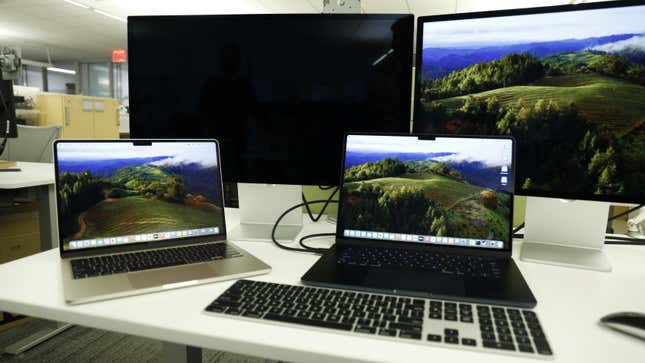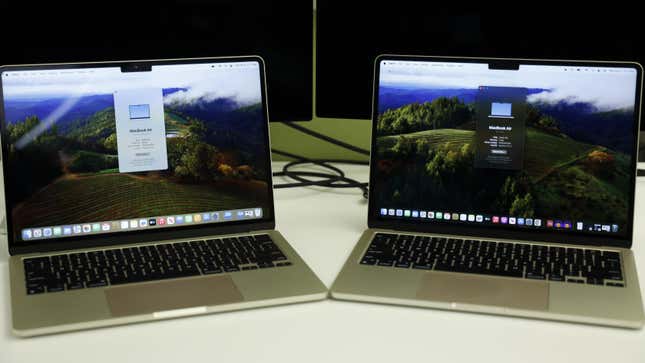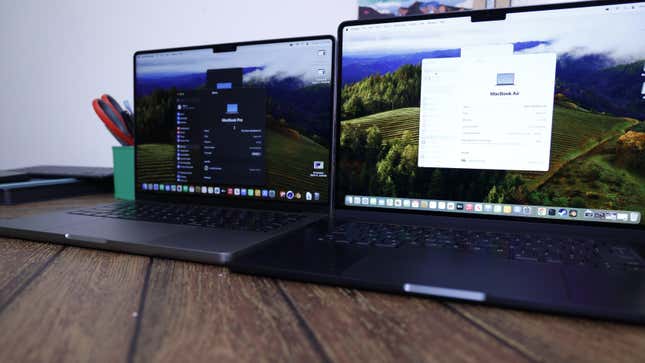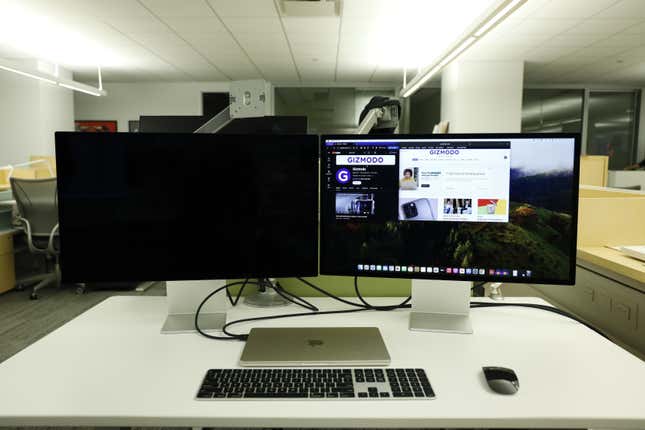MacBook Air with M3 13- and 15-Inch
The Macbook Air redesign from two years ago is still just as silent, slim, and comfortable as you expect, but you won’t see a massive difference from M2.
The MacBook Air is a good choice for an ultra-thin, though fully capable laptop, regardless of whether you opt for the 15- or 13-inch design. It’s everything you might expect from Apple, but it’s not so different from M2 that you should feel the need to switch. What’s most concerning is how Apple’s MacBook Pro 14 is sitting a little too close to the power of the slimmer model, and more ports don’t necessarily justify the higher cost.
MacBook Air 13 starting at $1,099 (Reviewed at $1,499), MacBook Air 15 starting at $1,299 (Reviewed at $1,799)
Pros
Great performance for its size with M3
Screen and sound are still high-quality
You can’t knock Apple’s lightweight design
The 15-inch MacBook Air approaches the capabilities of the M3 MacBook Pro
Cons
There’s not enough of new stuff to justify switching from M2 to M3
The 15-inch MacBook Air approaches the capabilities of the M3 MacBook Pro
If I had to think of the tech I’ve used most often in my day-to-day, I wouldn’t usually consider my phone first. If I ruminate long and hard enough, considering the number of person-hours that go into my work, I would consider my 13-inch M1-powered MacBook Air as my go-to device, like my oft-beleaguered, put-upon sidekick. I’ve used a lot of laptops just at the start of this year, but in terms of pure productivity, I find myself casting longing glances at the old lightweight standby laptop. In that way, the new M3-powered MacBook Airs are simple, sweet, and comfortable; they soothe the soul with their familiarity.
Does familiarity breed contempt? Not in this case, though I still wonder if Apple might eventually create an ultra-thin laptop that can do everything you want without compromise. The $1,099 M3 MacBook Air is as good as it has always been. These sharp, well-designed laptops don’t sacrifice much for their slim design. They were good before and are now, which hasn’t changed much with the transition from M2 to M3. Now that the M2 is $100 cheaper at $999 new from Apple, new customers have an interesting choice. Is the M3 version better than the M2? Yes. Is it $100 worth of better? It depends if you want extra battery life and the ability to connect to two external monitors.
Now that the latest version of the Air with the M3 chip has taken the spotlight, I’m again reminded just how valuable a lightweight laptop is for everyday, humdrum productivity. However, that comfort implies that I’m not surprised or even entirely enthused by the latest refresh of the MacBook Air line, either the 13- or 15-inch version.
They’re great laptops, but could I honestly tell I was using an M1 chip versus a M3? For the most part, no. Benchmarks show a vast difference between the three M-series chips—especially the M1 and M3—but I wish Apple had provided more updates to the laptop’s design to complement the new chip. It’s the same shell as the M2 version down to the still-annoying notch hanging on top of the screen like a stalactite dangling precariously above whatever you’re working on.
The first-of-its-kind 15-inch MacBook Air with M2 Apple finally unveiled last year proved that the Air’s lightweight design worked just as well with a bigger screen, and the same is true with the new M3 version. The 13-inch version that saw the light in 2022 was also a grand old-time.
However, the question becomes whether to opt for a baseline, $1,599 14-inch MacBook Pro compared to the cheaper, top-end 15-inch MacBook Air. Both come with identical chips, and each laptop sports a bare 8 GB of RAM at the most affordable price. Our benchmarks show that each PC with the same stats is practically identical.
So what we have now is a somewhat confusing lineup for the layman who wants to buy a new Apple laptop. The regular Apple buyer probably isn’t trying to haggle over the very minute difference in price, power, and portability. Other productivity-focused laptops, such as the MSI Prestige AI EVO, hover around the same price as the top-end MacBook Airs and comparable PCs are constantly becoming slimmer and lighter. Apple may soon have a fight on its hands if it wants to stay at the top of the light laptop heap.
MacBook Air with M3 Form Factor and Design
The MacBook Air is Still Light and Comfortable
Apple kept the same design as last year’s 15-inch MacBook Air, which, in effect, was an upscaled version of the existing 13-inch flat design first introduced in 2022. From the outside, it looks exactly the same as before, which is fair enough, considering the last MacBook Air design was generally good enough. The 13-inch still weighs 2.7 pounds, while the 15 sits at 3.3 pounds.
Even with the fanless design, MacBook Airs just do not get hot, even under stress. During regular use, the warmest the 15-inch version ever got was below 84 degrees Fahrenheit toward the screen. And all that’s very good because the Air is dead silent. There’s no sound of fans, even under stress. If you’re the type who can’t stand any sound at all that would distract you from your work, the MacBook Air is pretty much uncontested.
During intensive tasks, including playing games, the MacBook Air gets a bit hotter, up to above 110 degrees Fahrenheit around the screen and around 96 degrees on the keyboard. That’s nothing that would make a typical gaming laptop user hiss and waggle their fingers as if they’ve stuck their piggies in the fire, but perhaps the regular MacBook Air user who hasn’t had much chance to game might be surprised at their warm fingers.
The colorways are largely the same as last generation, though the Midnight blue-black color now has the anodized layer to reduce fingerprints, the same as the new full black color of the higher-end MacBook Pros. Put them side by side; they’re not the same hue. I personally prefer the deeper gray of the Pro, but the extra anti-fingerprint capabilities of the new version are a bit more pleasant for greasy-handed folks like me.
MacBook Air with M3 Screen and Sound
What You Should Expect from Apple

The 15-inch version differs from the 13-inch in that it houses a 6-speaker system with the Apple-brand force-canceling woofers. The smaller Air only uses the four-speaker system, so while its sound is certainly fair for a smaller device, the 15-inch has a better quality that’s more in line with the Pro models, even though it lacks the gratings to either side of the keyboard.
The screen is the same IPS LCD Liquid Retina displays as other MacBooks and the same as the previous MacBook Air. The 15-inch version sits at 2880 by 1864 resolution with a touted 500 nits. If you have seen any MacBook display from the past two years, it’s the same thing here. That’s not a bad thing. I’ve long enjoyed the look of MacBook screens, and it’s not like any of us were expecting OLED on this year’s Air refresh. However, we’re still crossing our fingers for OLED MacBook Pros and, probably sooner, OLED iPads.
One newly touted improvement over the past MacBook Airs is the M3 version’s capacity to hook up to two external monitors in clamshell mode. No, you can’t keep the Air’s screen going while running your regular display, which seems deliberate if still frustrating for folks who live and breathe the multi-screen experience. Meanwhile, the MacBook Pro the M3 Pro silicon supports up to two external displays while still displaying the laptop screen. An M3 Max-powered Pro can do up to four external displays with the screen on. The regular 14-inch MacBook Pro with M3 will eventually support up to two displays in clamshell mode like the Air does in a future update, though Apple has not said when that could be coming down the pike.
At the very least, running the MacBook open with two monitors would be nice, but now you’ll still need to use an external keyboard and mouse/trackpad to use all your equipment. But it does work if you’re down to multiply the number of monitors you’re using at once. You might need to use an external port doc since you would use the MacBook Air’s only two USB-C ports.
MacBook Air with M3 Performance
Performance is Far Better than M1, but not Leagues Above M2
Even though the MacBook Air is designed to walk the razor’s edge of power and portability, it will still be limited by its design. The 13- and 15-inch models we received for review came with 16 GB of RAM and 512 GB of SSD memory. The 15-inch version has a 10-core GPU compared to the 13-inch 8-core, so we tested most of its gaming capabilities on the larger version. If you want to do any graphically intense task in the Air, you should opt for the larger laptop.
Apple wants to directly compare its baseline M3 to the power and power consumption of the latest-generation Intel Core i7 processors. Apple sets its prices for its products without much eye to competitive pricing, and the M-series chips will easily beat lower-costed i7-based laptops on pure benchmarks, depending on the make and model of the CPU. To note from the get-go, there’s no practical performance loss between the 13-inch and 15-inch versions. That means that no matter whether you want to go for the larger or smaller screen, you can expect the same capabilities.
The base M3 can punch above its weight, and most users still on an Intel processor MacBook would immediately tell the difference on the latest machine. Still, it’s unlikely to hit Intel’s latest, higher-end i7s. The M3 chip was able to meet or beat the Intel Core i7 14700-HX found in the latest Acer Predator Helio Neo 16 on single-core CPU tests, though it lagged in multi-core settings in Geekbench and Cinebench benchmarks. You’d need to see the power of an M3 Pro or M3 Max before comparing Apple’s chips to the Intel Core i9 series.
I still wish we could see a Pro or Max-level chip under Apple’s ultra-thin frame. That might not be possible with the fan-less design, but I can still dream. Asus, with its ROG Zephyrus G14, managed to pack an Intel Core i9 and up to an Nvidia RTX 4070 into a 1.56-centimeter-thick frame, only about .43 centimeters thicker than the MacBook Air, though, of course, it’s also packing some noisy fans.
It certainly is capable of more intensive tasks than your typical browsing and Netflix watching, but if you’re a professional, you still would want to opt for the more powerful M3 Pro, M3 Max, or a comparable CPU and GPU combo from the many PC makers around. In Blender benchmarks, where we get the PC to render an image of a BMW, the M3 MacBook Airs took a little under four minutes running on either CPU or GPU. As you might expect, the MacBook Pro with M3 Max and 48 GB of RAM blasts through that same test in half the time.
Macs aren’t known for gaming, and the MacBook Air is the least of all. Still, I found the laptops could handle some light gaming and even play a few more hardcore titles at reasonable settings. I tried out a few games Macs currently support, such as last year’s Lies of P and the Resident Evil 4 remake. The former can hit 60 FPS on medium to low settings at 2560 by 1600 resolution, less than the max 2880 by 1800, and also using Apple’s MetalFX upscaling tech. That’s fair enough, and in other less-demanding titles, you can expect similar compromises to ensure the best playable framerates.
It’s the same story for Resident Evil 4, which could sustain 60 FPS after lowering the resolution and setting MetalFX to “Performance” mode. Mind you, these games were developed or redeveloped to work well on Apple’s hardware. I was most curious to see if I would experience thermal throttling with the MacBook Air design, but while I did experience a few frame hiccups, they didn’t last long. In Baldur’s Gate III, I found you’d get 40 FPS indoors on medium to low settings and 30 outdoors, even with the AMD FSR scaling set to performance. That’s good enough for a turn-based game but not the optimal way to play.
So, is it more powerful than the M1 MacBook Air? Yes, certainly. The M3 does more than 1,000 points in single-core and a little under 4,000 points more in multi-core on Geekbench. The M3 nearly doubles the M1’s score on 3D Mark’s Wild Life Extreme test. How about the M2? It was 500 points higher in single-core and closer to 2,000 in multi-core. That’s a step up, but not as dramatic as the four-year difference.
If you’re already used to the M1 or M2, you won’t feel any difference running daily browsing tasks or watching videos online. Even with the new WiFi 6E connection on the M3 Airs, you won’t see a dramatic uptick in speeds, whether online or off, for daily productivity. If you’re expecting to do any heavier lifting on your MacBook Air, you can expect performance gains. But unless you’re dead set on an ultra-thin laptop, the Pro models with options for more RAM may still be the better option.
Saying that the M3 MacBook Air is, for all intents and purposes, nearly identical to the power of the MacBook Pro with the baseline M3. The Pro will still have the slight edge in sound quality and storage, but honestly, it makes the cheapest Pro that much more of a head-scratcher, considering you can get a thinner laptop for cheaper.
MacBook Air With M3 Battery Life
It Will Keep Cooking for Well Into the Day

Apple promised 15 hours of use with simple web browsing or 18 hours of video playback on its latest MacBook Airs. That’s a fair bit more than Apple promises to get from its MacBook Pro models, but in the end, “all-day battery life” is a better descriptor for anything beyond 12 hours before you inevitably plug it in to charge. The 13-inch uses a 52.6 Whr battery while the 15-inch is at 66.5 Whr, so considering its size, the latest MacBook Air is still efficient.
In the end, all-day battery life is really what matters. I went an entire workday and a half on the 13-inch MacBook Air with M3 before seeing the battery bar dip into the red. Still, battery life will drop if you do anything more than basic browsing and productivity. A short gaming session on the 15-inch laptop, taking up less than an hour unplugged, drained the battery about 30%. This is to be expected, and with the small, 30W power brick and MagSafe charger, it takes a little more than an hour to go from running on empty to a full tank.
The laptop also supports up to a 70W adapter for faster charging. However, if you truly want your portable PC to remain portable, the 35W (the cheapest 13-inch model with a 30W brick) is perfectly fine for topping the Air off overnight.
The M3 MacBook Air is a Fine Laptop, but the MacBook Pro 14 Now Seems Overpriced

If you want the smallest version of Apple’s laptop line, the 13- or 15-inch MacBook Air with M3 makes a lot of sense. You won’t be disappointed if you want to upgrade from the M1, especially the Intel-based MacBooks. If you’re thinking about upgrading from the M2, know you’ll be receiving what will virtually be the same machine, though with added dual-monitor connectivity, a slightly better battery, and slightly more power under the hood.
However, I need to point out just how complicated the MacBook SKU is getting now that the MacBook Air is so close to the MacBook Pro. Considering the $1,599 starting MacBook Pro seems underwhelming just in terms of pure stats, it first seems like you’re better off getting a M3 MacBook Air if you’re looking for a good all-around laptop experience. A MacBook Pro with 16 GB of memory costs just under $2,000. Considering the pricing of both models, the 16 GB RAM and 512 GB SSD version of the MacBook Air 15 cost $1,700; you have to wonder what’s there to justify the extra $300.
Is all this indicative that the MacBook Air is more powerful than ever or that the lower-end version of the MacBook Pro isn’t powerful enough? Perhaps both? Perhaps neither? Or is it better to say Apple’s pricing model might be getting away from itself? My money’s on the latter.
Update 03/12/24 at 8:33 a.m.: This post was updated to correct the details regarding the external screen capabilities of the M3 MacBook Pros.
Trending Products

Cooler Master MasterBox Q300L Micro-ATX Tower with Magnetic Design Dust Filter, Transparent Acrylic Side Panel…

ASUS TUF Gaming GT301 ZAKU II Edition ATX mid-Tower Compact case with Tempered Glass Side Panel, Honeycomb Front Panel…

ASUS TUF Gaming GT501 Mid-Tower Computer Case for up to EATX Motherboards with USB 3.0 Front Panel Cases GT501/GRY/WITH…

be quiet! Pure Base 500DX Black, Mid Tower ATX case, ARGB, 3 pre-installed Pure Wings 2, BGW37, tempered glass window

ASUS ROG Strix Helios GX601 White Edition RGB Mid-Tower Computer Case for ATX/EATX Motherboards with tempered glass…











